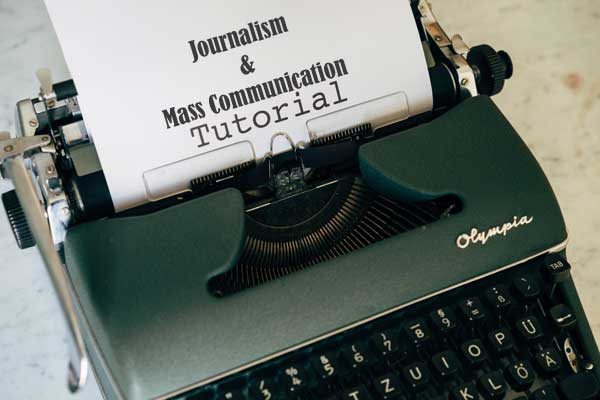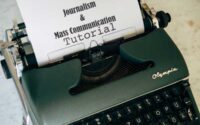Journalism MCQ Objective Type Question
Aspirants can find the Journalism MCQ Objective Type Question with answers here. Journalism MCQ Objective Type Question for Both written examination and interview are available here. The Candidate who is appearing for Journalism can download the MCQ Objective Type Question from the link given.

Journalism MCQ Objective Type Question are available in our web page. However, to help the aspirants in getting their dream jobs we have given the direct download link for the Journalism MCQ Objective Type Question Pdf in the section below. We advise the applicants who are in search of Journalism MCQ Objective Type Question to refer the syllabus and exam pattern details.
MCQ Objective Type Question on Journalism
1. The word ‘journalist’ is derived from:
(A) Journalography
(B) Diurna
(C) Diurnalis
(D) Journology
2. Which was the first newspaper to offer an online edition in India?
(A) The Times of India
(B) The Nav Bharat Times
(C) The Hindustan Times
(D) The Hindu
3. Transforming thoughts, ideas and messages into verbal and non-verbal signs is referred to as:
(A) Mediation
(B) Encoding
(C) Decoding
(D) Channelisation
4. The Press Council of India is a
(A) non-judicial body
(B) non-statutory body
(C) quasi-judicial body
(D) private body
5. Short wave frequencies are used for radio communication of
(A) short distance
(B) long distance
(C) location specific distance
(D) specific distance
6. In communication, cognitive dissonance brings about psychological:
(A) Adjustments
(B) Passivity
(C) Dynamism
(D) conflicts
7. When a straight forward proposition is used in advertising, it is called
(A) Emotional approach
(B) Creative approach
(C) Dogmatic approach
(D) Typical approach
8. The list of population elements from which the sample is drawn is called
(A) population register
(B) sample register
(C) sampling frame
(D) population frame
9. Identify the newspaper which is published in tabloid form.
(A) The Telegraph
(B) The Deccan Herald
(C) The Navbharat Times
(D) Mail Today
10. Which of the following traditional forms of communication uses rasa, tal, laya and bhava?
(A) Yatra
(B) Pala
(C) Bhaona
(D) Kuchipudi
11. Manipulation is always a part of
(A) Historical research
(B) Fundamental research
(C) Descriptive research
(D) Experimental research
12. The Radio Club of Bombay started its first regular programmes in June 1923. Which of the following was second after Bombay to start broadcasting service in November 1923?
(A) Madras
(B) Amritsar
(C) Lucknow
(D) Calcutta
13. World Press Freedom Day is celebrated on which date since 1991?
(A) 3rd May
(B) 16th November
(C) 29th January
(D) 15th August
14. The signals through fibre-optics are transmitted by
(A) light waves
(B) electric waves
(C) magnetic waves
(D) sound waves
15. Identify the shot that is not frequently used in television.
(A) Close-up
(B) Long shot
(C) Extreme close-up
(D) Mid-shot
16. Who among the following is a celebrated cartoonist?
(A) Bachhi Karkaria
(B) Arvind Adiga
(C) Abu Abraham
(D) Sevanti Ninan
17. An inductive method is normally used in
(A) statistical tests
(B) content analysis
(C) path analysis
(D) exploratory research
18. What is ‘ambient light’?
(A) Back light placed behind the object
(B) Back ground light
(C) Dim night light
(D) Natural light available to shoot
19. Newcomb’s ABX model is an extension of
(A) cultivation theory
(B) socialisation theory
(C) pleasure theory
(D) balance theory
20. Rain bow is the FM channel of AIR. Gold is the FM channel of which of the following?
(A) The Times of India
(B) Reliance
(C) AIR
(D) Anna University
| Questions and Answers | Mock Test |
| Interview Question | Sample Question |
| MCQ Objective | Model Papers |
| Question Bank | Quiz |
21. What would you call the journalism that promotes civic commitment and citizen participation in a democratic process?
(A) Advocacy journalism
(B) Public journalism
(C) Alternative journalism
(D) Counter media
22. The positivist paradigm adopted by researchers in mass communication, makes a liberal use of:
(A) Descriptions
(B) Fictional narratives
(C) Aesthetics
(D) Quantifications
23. Ballooning in cartoons contain:
(A) Picture
(B) Guidelines
(C) Sound bytes
(D) Text
24. Which form of advertising is heavily used to introduce a new product?
(A) Persuasive advertising
(B) Reminder advertising
(C) Inferential advertising
(D) Informative advertising
25. Assertion (A): The RTI has created hurdles for good governance in India.
Reason (R): The RTI has become a credible source of news for investigative journalism.
(A) Both (A) and (R) are true
(B) Both (A) and (R) are true, but (R) is not the correct explanation of (A)
(C) (A) is true but (R) is false
(D) (A) is false but (R) is true
26. Assertion (A): Monogamy is the most common form of marriage in the contemporary society.
Reason (R): Status of women get enhanced through monogamy.
(A) Both (A) and (R) are true and (R) is the correct explanation of (A)
(B) Both (A) and (R) are true and (R) is not the correct explanation of (A)
(C) (A) is true but (R) is false
(D) (A) is false but (R) is true
27. Assertion (A): Media cannot set any agenda for the society.
Reason (R): Media audience select contents of their choice.
(A) Both (A) and (R) are true
(B) Both (A) and (R) are true but (R) is not the correct explanation of (A)
(C) (A) is true but (R) is false
(D) (A) is false but (R) is true
28. Assertion (A): Unlike mass communication, semiology prefers a microscopic approach.
Reason (R): In semiology, the emphasis is on deconstruction of texts with surgical precision.
(A) Both (A) and (R) are true
(B) Both (A) and (R) are true but (R) is not the correct explanation of (A)
(C) (A) is true but (R) is false
(D) (A) is false but (R) is true
29. Assertion (A): New media has a negative impact on the writing skills of new generation.
Reason (R): New media has altered the art of writing.
(A) Both (A) and (R) are true
(B) Both (A) and (R) are true but (R) is not the correct explanation of (A)
(C) (A) is true but (R) is false
(D) (A) is false but (R) is true
30. Assertion (A): The Indian press has become quite distinct from the Western press during the last few years.
Reason (R): The Indian press has registered a quantitative jump in terms of number of publications and circulation.
(A) Both (A) and (R) are true
(B) Both (A) and (R) are true but (R) is not the correct explanation of (A)
(C) (A) is true but (R) is false
(D) (A) is false but (R) is true
31. The correct sequence of adopters of innovation is
(A) Innovators—Early adopters—Laggards— Early majority—Late majority
(B) Laggards—Late majority—Early majority—Early adopters—Innovators
(C) Innovators—Early majority—Early adopters—Late majority—Laggards
(D) Innovators—Early adopters—Early majority—Late majority—Laggards
32. Identify the correct chronological sequence based on their establishments.
(A) Havas, Associated Press, PTI, UNI
(B) Havas, PTI, Associated Press, UNI
(C) Associated Press, Havas, PTI, UNI
(D) UNI, PTI, Associated Press, Havas
33. Identify the correct chronological order of:
(A) The Hindu, The Times of India, The Statesman, The Hindustan Times
(B) The Times of India, The Hindu, The Hindustan Times, The Statesman
(C) The Times of India, The Statesman, The Hindu, The Hindustan Times
(D) The Statesman, The Times of India, The Hindu, The Hindustan Times
34. Identify the correct sequence of production of visual programmes.
(A) Rough cut, Dailies, Fine cut, Final cut
(B) Dailies, Rough cut, Fine cut, Final cut
(C) Rough cut, Fine cut, Dailies, Final cut
(D) Dailies, Final cut, Fine cut, Rough cut
35. Identify the correct sequence of research in content analysis.
(A) Data analysis, Subject categories, Units of analysis, Coding
(B) Units of analysis, Subject categories, Coding, Data analysis
(C) Subject categories, Units of analysis, Coding, Data analysis
(D) Coding, Subject categories, Units of analysis, Data analysis
36. Identify the correct sequence of Dennis McQuail’s five basic functions of media.
(A) Information, Continuity, Correlation, Entertainment, Mobilisation
(B) Information, Correlation, Continuity, Entertainment, Mobilisation
(C) Mobilisation, Information, Continuity, Correlation, Entertainment
(D) Correlation, Information, Mobilisation, Entertainment, Continuity
37. Which of the following is a mismatch?
(A) DPA—Germany
(B) Xinhua—China
(C) A.P—U.S.A
(D) UPI—U.K
38. Assertion (A) : Verbal language and photography are fine examples of representational codes.
Reason (R) : Both of the perform referential functions.
(A) Both (A) and (R) are true.
(B) Both (A) and (R) are true but (R) is not the correct explanation of (A).
(C) (A) is true but (R) is false.
(D) (A) is false but (R) is true.
39. Assertion (A) : Traditional media in India are mostly mythological due to audience preference.
Reason (R) : Modern mass media are responsible for this as they have made audiences prefer traditional media.
(A) Both (A) and (R) are true.
(B) Both (A) and (R) are true but (R) is not the correct explanation of (A).
(C) (A) is true but (R) is false.
(D) (A) is false but (R) is true.
40. Assertion (A) : The Social media have become a global craze in recent times.
Reason (R) : Social media cut across the barriers of age, sex, culture and status.
(A) Both (A) and (R) are true.
(B) Both (A) and (R) are true but (R) is not the correct explanation of (A).
(C) (A) is true but (R) is false.
(D) (A) is false but (R) is true.
41. Assertion (A) : In the near future newspapers will disappear.
Reason (R) : The rate of growth of television and internet is very high.
(A) Both (A) and (R) are true.
(B) Both (A) and (R) are true but (R) is not the correct explanation of (A).
(C) (A) is true but (R) is false.
(D) (A) is false but (R) is true.
42. Identify the correct sequence of development support communication by John. L. Woods.
(A) Knowledge generators, political leaders, intermediate groups, knowledge users.
(B) Political leaders, knowledge generators, intermediate groups, knowledge users.
(C) Knowledge users, intermediate groups, political leaders, knowledge generators.
(D) Knowledge generators, intermediate groups, knowledge users, political leaders.
43. List the correct sequence of earliest newspapers published in India in English:
(A) Brahmanical Magazine, Hickey’s Gazette, Harijan, Young India.
(B) Hickey’s Gazette, Harijan, Brahmanical Magazine, Young India.
(C) Hickey’s Gazette, Brahmanical Magazine, Young India, Harijan.
(D) Hickey’s Gazette, Brahmanical Magazine, Harijan, Young India.
44. As regards the use of space, identify the order of distance zones in relation to body language.
(A) Personal zone, Intimate zone, Social zone, Public zone
(B) Intimate zone, Personal zone, Public zone, Social zone
(C) Intimate zone, Personal zone, Social zone, Public zone
(D) Personal zone, Public zone, Social zone, Intimate zone
45. Identify the correct chronological order of:
(A) Cable, Video, Satellite, e-mail
(B) Satellite, Cable, Video, e-mail
(C) e-mail, Cable, Satellite, Video
(D) Cable, Video, e-mail, Satellite
46. Identify the correct sequence of the contributions by the following communication scholars.
(A) Wilbur Schramm, Harold Lasswell, Shannon and Weaver, E. M. Rogers
(B) Harold Lasswell, Shannon and Weaver, Wilbur Schramm, E. M. Rogers
(C) Harold Lasswell, Wilbur Schramm, Shannon and Weaver, E. M. Rogers
(D) E. M. Rogers, Wilbur Schramm, Harold Lasswell, Shannon and Weaver
47. What is the correct sequence?
(A) Radio, Theatre, Film, Television
(B) Theatre, Radio, Film, Television
(C) Film, Theatre, Radio, Television
(D) Theatre, Film, Radio, Television
48. Identify the correct chronological sequence of the release of the following films.
(A) Bicycle Thieves, Citizen Kane, Nanook of the North, Birth of a Nation
(B) Birth of a Nation, Nanook of the North, Bicycle Thieves, Citizen Kane
(C) Nanook of the North, Citizen Kane, Bicycle Thieves, Birth of a Nation
(D) Birth of a Nation, Nanook of the North, Citizen Kane, Bicycle Thieves
49. Which of the following is a mismatch?
(A) The Times of India — Bhubaneswar
(B) Asian Age — Kolkata
(C) The Hindu — Visakhapatnam
(D) Asian Age — Mumbai

